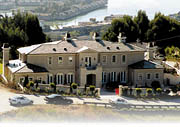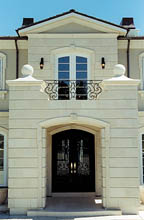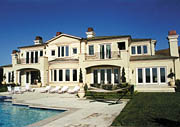

Mark Chambers, owner of Rydan General Construction, of Vacaville, Calif., says the luxury homes he finishes are so visually appealing that passersby pull their cars over to take a long second look. He and his crew of eight apply limestone plaster and cast limestone to the interiors and exteriors of high-end new and renovated homes.
“We do a very specialized part of the finished product,” says Chambers, explaining that his company works on homes that average 5,000 to 6,000 square feet and cost $3 million to $15 million. Dramatic in their own right, “We get all the credit. They see the stone and they don’t even notice anything else.”
It’s real stone, but it’s different from cut stone. To achieve a stone effect on the homes’ exteriors, Chambers and his crew trowel on a limestone product called ArcusStone and finish it to produce a cut-stone look. ArcusStone is a blend of limestone minerals, bonding agents and other ingredients, with a Portland cement base as its element for strength. It adheres to most substrates, including stucco brown coat, painted or unpainted gypsum board, some metals, coated foam, brick, concrete and cementitious wood.

Old world new again
One of Rydan’s recent projects was an expansive home in Tiburon, Calif., featuring the timeless Mediterranean style of architecture. The timeless home called for a timeless finish.“It ages like regular stone because it’s limestone,” Chambers says. “It’s a natural material reformulated into a new product.”
For the surrounding walls and exterior of the home, the company used the ArcusStone product two different ways to achieve its old-world look.
For the walls, which go around the grounds and pool, the crew troweled the product in a 1⁄4-inch thickness directly over poured concrete and block. They then scored out the pattern and returned the next day to grout the cracks, finishing the stone effect. In other cases, homeowners might opt to skip the grout step for a cracked, distressed edge.
Chambers says depending on the type of look he wants to achieve, he can sift out larger particulate from the mix. For the walls, he used a typical textured “chateau” finish.
“We take the extra time, and when we finish, it’s absolutely perfect,” Chambers says. “I like being in the field and actually doing work with the guys. They are highly skilled. It takes time to get a feel for the materials.”
Carol Kavalaris, president of ArcusStone, of Oakland, Calif., says the company trains contractors—most of whom are already plasterers or stucco contractors—to apply the material.
“Not that it’s difficult to do, but there’s a procedure,” she says. “They trowel it on and wait a little while—about an hour—and then they scratch it with the edge of a trowel and it creates texture. They let it set again and they come back and hone it. It can be left with a rough texture or it can be honed or polished.”
It’s important the crew stick to a pre-drawn plan for scoring, Chambers explains. As much as two hours after the plaster is applied, it is virtually impossible to cut into the plaster without a diamond blade.
Blocking progress
For the exterior walls of the actual house, the crew used a different technique with the same material. In the company’s shop, they coated 16-inch by 24-inch foam panels with the product in a fine grain and let it set. Then they took the panels to the site and applied them to the exterior surface as if they were blocks of stone.“We lay out the block pattern that we want, in size, proportion,” says Chambers, adding that love of drawing and previous work in the ultra-precise tool and die trade provided good background for this part of the job. “On his house, he had a staggered block pattern.”
“The reason they did that on the house was that they wanted it to look like thick stones—so that each panel looks like it’s approximately 2 inches thick because of the chamfered edges and deep reveals,” Kavalaris says. “The moldings around the sill and the moldings around the doors are also all foam with the stone coating over it.”
In addition to field-applying the product and coating it over foam, ArcusStone can be cast to create other architectural elements, like columns and fireplaces. It is the only application of the product not performed with a trowel and the only one that’s not technically a finish.
“Cast stone is something we came up with later because the contractor would be working on the building and it would have this wonderful limestone,” says Kavalaris, “and then the cast-concrete details wouldn’t look right.”
The cast stone can receive the same texturing and custom coloring as both trowel-applied and foam-coated stone, she says. The result is a uniform look, as if all the pieces of stone came from the same quarry.
“What we’ve done is created a whole system of ways to use stone coating, so if you’re doing stone coating and you need to use different materials, they all look the same,” she explains, adding that cast stone can be a good choice for something like a solid column, and coated foam is preferable for parapets or window surrounds because of its light weight.
It’s also more versatile than cut stone, she says. It may be carved, textured and colored as specified by the owner or architect. It is also easier to apply to curves, arches or irregular shapes and can be wrapped around corners to create the illusion of solid blocks of stone.
“The cost and availability of labor to build with cut stone often makes that choice unattractive,” Kuralaris says. “Very often, architects have told me it’s almost impossible to design with cut stone because of the expense and seismic issues.”
Chambers says the design possibilities with ArcusStone are virtually endless, and he has used the products on nearly every surface inside and outside his homes. Adding to the beauty of the product are the unique carvings he can incorporate into it—for example, a continuous grape leaf pattern he carved in a column for one customer.
He has found the products so varied, in fact, that he has devoted 100 percent of his business to their application. He advises other contractors that work with it to do the same.
“It’s not something you can do in addition to something else,” Chambers says. “People have to be skilled. It can be unforgiving. You can’t have a crew working on framing and then have them do the stonework.
“Do the time it takes to do it,” he insists. “Live and breathe the product for a few years and pay your dues. It’s a very rewarding material.”


